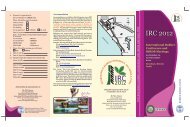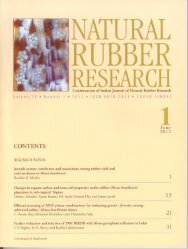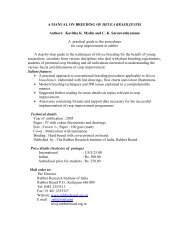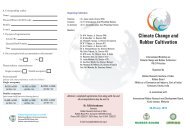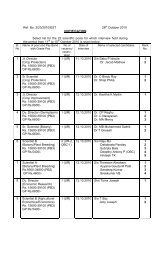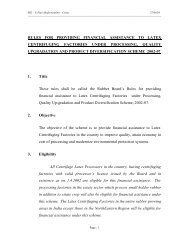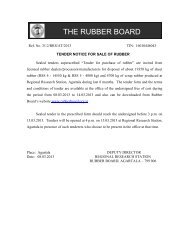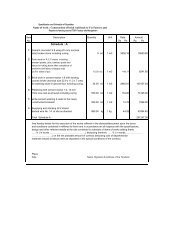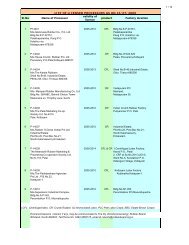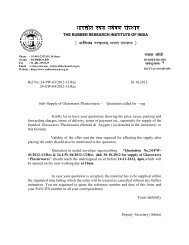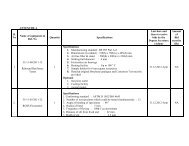to read the publication - Rubber Board
to read the publication - Rubber Board
to read the publication - Rubber Board
You also want an ePaper? Increase the reach of your titles
YUMPU automatically turns print PDFs into web optimized ePapers that Google loves.
Natural <strong>Rubber</strong> Research Volume 24 z Number 1 z 2011<br />
CONTENTS<br />
RESEARCH PAPERS<br />
Impact of climate warming on natural rubber productivity in different<br />
agro-climatic regions of India<br />
P.R. Sa<strong>the</strong>esh and James Jacob 1<br />
Evidence for climate warming in some natural rubber growing regions of South India<br />
Shammi Raj, P.R. Sa<strong>the</strong>esh and James Jacob 10<br />
Over-expression of MnSOD and related drought <strong>to</strong>lerant traits in MnSOD<br />
transgenic Hevea brasiliensis<br />
R. Jayashree, S. Sobha, K. Rekha, R. Supriya, M. Vineetha, S. Sushamakumari,<br />
R.G. Kala, P.K. Jayasree, A. Thulaseedharan, K. Annamalainathan, D.B. Nair,<br />
S. Sreelatha, R. Krishnakumar and James Jacob 18<br />
Ecosystem flux measurements in rubber plantations<br />
K. Annamalainathan, P. R. Sa<strong>the</strong>esh and James Jacob 28<br />
Application of remote sensing and GIS in determining erodibility of rubber soils<br />
Shankar Meti, B. Pradeep, M.D. Jessy and James Jacob 38<br />
Yield of modern Hevea clones and <strong>the</strong>ir response <strong>to</strong> wea<strong>the</strong>r parameters across<br />
diverse environments<br />
T. Meenakumari, J.R. Meenat<strong>to</strong>or, T.A. Soman, S.K. Dey, Gitali Das, Shammi Raj,<br />
T. Sailajadevi, Ramesh B. Nair, K. Anitha Raman, T. Gireesh and Kavitha K. Mydin 44<br />
<strong>Rubber</strong> yield of certain clones of Hevea brasiliensis and its relationship<br />
with climate variables<br />
T. Gireesh, Shammi Raj, Kavitha K. Mydin and V.C. Mercykutty 54<br />
Physiological evaluation of a few modern Hevea clones for intrinsic drought <strong>to</strong>lerance<br />
K.V. Sumesh, P.R. Sa<strong>the</strong>esh, K. Annamalainathan, R. Krishnakumar,<br />
Molly Thomas and James Jacob 61<br />
Physiological traits for identification of potential drought <strong>to</strong>lerant accessions from<br />
wild Hevea germplasm<br />
D.B. Nair, M.A. Mercy, K. Annamalainathan, R. Krishnakumar and James Jacob 69<br />
Juvenile growth response of selected wild Amazonian accessions and hybrid<br />
Hevea clones of Wickham origin in a drought stressed environment<br />
M. A. Mercy, Kavitha K. Mydin, T. Meenakumari and D. B. Nair 76<br />
Patron<br />
Ms. Sheela Thomas IAS<br />
Edi<strong>to</strong>r-in-Chief<br />
Dr. James Jacob<br />
Edi<strong>to</strong>r<br />
Mr. Sabu P. Idicula<br />
Guest Edi<strong>to</strong>r<br />
Dr. R. Krishnakumar<br />
EDITORIAL BOARD<br />
Secretary<br />
Dr. C. P. Reghu<br />
Associate Edi<strong>to</strong>rs<br />
Dr. R. Krishnakumar<br />
Dr. Kochuthresiamma Joseph<br />
Dr. Siby Varghese<br />
Dr. Sherin George<br />
Dr. Jayashree Madhavan<br />
Dr. Thakurdas Saha<br />
Edi<strong>to</strong>rial Committee<br />
Members<br />
Dr. D. Chaudhuri<br />
Dr. Kavitha K. Mydin<br />
Ms. Binni Chandy<br />
Treasurer<br />
CA. Zachariah Kurian
Comparison of root trainer and polybag grown planting materials of Hevea<br />
T.A. Soman, M. Suryakumar, Kavitha K. Mydin and James Jacob 84<br />
Some good agricultural practices for adapting rubber cultivation <strong>to</strong> climate change<br />
Sherin George,V.K. Syamala, Sabu P. Idicula and N. Usha Nair 91<br />
Exchange properties of soils in <strong>the</strong> traditional rubber growing tract in South India<br />
Mercykutty Joseph 97<br />
Performance of some Hevea clones under <strong>the</strong> changing climate of<br />
sub-Himalayan West Bengal<br />
Gitali Das, R. S. Singh, S. Meti and D. Chaudhuri 106<br />
Seasonal variations in yield and associated biochemical changes in<br />
RRII 400 series clones of Hevea brasiliensis<br />
S. Sreelatha, Kavitha K. Mydin, Sheela P. Simon, R. Krishnakumar,<br />
James Jacob and K. Annamalainathan 117<br />
Critical wea<strong>the</strong>r fac<strong>to</strong>rs influencing <strong>the</strong> incidence and severity of Corynespora<br />
leaf fall disease in Hevea<br />
Shammi Raj and Annakutty Joseph 124<br />
Is climate inimical <strong>to</strong> <strong>the</strong> development of abnormal leaf fall disease in<br />
natural rubber plantations in North East India?<br />
C. Bindu Roy, T. Sailajadevi, Shammi Raj, Nripen Kr. Gogoi and Jacob Ma<strong>the</strong>w 132<br />
Reduction in carbon dioxide emission in block rubber production by biomass gasification<br />
N. Rajagopal and Thomas Sebastian 140<br />
SHORT SCIENTIFIC COMMUNICATIONS<br />
Climate uncertainties and early establishment of young rubber plants<br />
in traditional rubber growing regions of India<br />
M. D. Jessy, R. Krishnakumar, K. Annamalainathan and James Jacob 145<br />
Potassium and silicon help young rubber plants tide over transient drought<br />
P. Prasannakumari, M.D. Jessy and K. Annamalainathan 150<br />
Variations in leaf fatty acid composition of different clones of Hevea brasiliensis<br />
Molly Thomas and Jayasree Gopalakrishnan 155<br />
Studies on <strong>the</strong> performance of Hevea in <strong>the</strong> changing climate of Garo hills (Meghalaya)<br />
A.P. Thapliyal, R.P. Singh, M.J. Reju, D. Chaudhuri, R. Krishnakumar and James Jacob 159<br />
Drought <strong>to</strong>lerance of modern Hevea clones grown in <strong>the</strong> North Konkan<br />
region of Maharashtra<br />
S. Ravichandran, Meena Singh, James Jacob, R. Krishnakumar, and K. Annamalainathan 165<br />
Influence of climate change on rubber honey production<br />
S. Devanesan, K.S. Premila and K.K. Shailaja 170<br />
GENERAL ARTICLE<br />
Impact of climate change on insect pests, pathogens and <strong>the</strong>ir natural enemies<br />
Suseelendra Desai and M. Srinivasa Rao 174<br />
Cover Page<br />
Eddy covariance system for ecosystem level CO2 and water vapous flux measurements<br />
See Annamalainathan et al., pages 28-37<br />
Figure in <strong>the</strong> inset shows long term change in maximum temperature at Kottayam.<br />
See Sa<strong>the</strong>esh and Jacob, pages 1-9
In this issue<br />
Natural <strong>Rubber</strong> Research is coming out for <strong>the</strong> first time with a special issue<br />
and <strong>the</strong> <strong>the</strong>me is Climate Change which is of <strong>to</strong>pical relevance. The articles<br />
appearing in this special issue are important on two accounts: (i) According <strong>to</strong><br />
<strong>the</strong> fourth assessment report of <strong>the</strong> Intergovernmental Panel on Climate Change,<br />
countries in South and South East Asia where most of <strong>the</strong> world’s natural rubber<br />
(NR) is traditionally grown are highly vulnerable <strong>to</strong> <strong>the</strong> adverse effects of global<br />
warming and climate change. (ii) Due <strong>to</strong> <strong>the</strong> increasing global demand for NR,<br />
its cultivation is being extended <strong>to</strong> hi<strong>the</strong>r<strong>to</strong> non-traditional areas that are often<br />
agro-climatically less congenial for its optimum growth and productivity. Thus,<br />
NR cultivation will increasingly experience climate stress, both in <strong>the</strong> traditional<br />
and non-traditional areas in <strong>the</strong> years ahead.<br />
Several articles in this issue give evidence for climate warming in both <strong>the</strong><br />
traditional and non-traditional areas of NR cultivation in India. The article by<br />
Sa<strong>the</strong>esh and Jacob (page 1) shows how this will have a profound adverse impact<br />
on NR productivity. In parts of North East India where severe cold during<br />
winter is presently a limiting fac<strong>to</strong>r for NR cultivation, climate warming has a<br />
stimula<strong>to</strong>ry effect on NR productivity. Moderate warming could make more<br />
areas in North East India suitable for growing NR in future.<br />
The article by Jayashree et al. (page 18) explains <strong>the</strong> successful development<br />
of a transgenic rubber plant that over-expresses MnSOD, imparting protection<br />
against water deficit stress in nursery studies. This is <strong>the</strong> first such report in<br />
natural rubber. Several articles in this issue discuss agronomic practices for<br />
managing adverse climatic conditions in <strong>the</strong> field. These independent studies<br />
suggest that clone RRII 430 may have an edge over <strong>the</strong> o<strong>the</strong>r clones in <strong>the</strong> RRII<br />
400 series in terms of survival under hot and dry conditions. The paper by Nair<br />
et al. (page 69) explains a fast and efficient method for screening large number<br />
of plants for intrinsic stress <strong>to</strong>lerance traits.<br />
Carbon dioxide sequestration and water flux rates of a young NR plantation<br />
estimated by <strong>the</strong> eddy covariance technique is reported by Annamalainathan<br />
et al. (page 28). This is <strong>the</strong> first such report from a perennial crop grown in<br />
India. The article by Meti et al. (page 38) used satellite images for <strong>the</strong> first time<br />
<strong>to</strong> estimate <strong>the</strong> vulnerability of rubber soils <strong>to</strong> erosion. Extreme rainfall events<br />
are a likely fallout of climate change and rubber plantations which are generally<br />
grown in slopes need <strong>to</strong> take special care against soil erosion.<br />
James Jacob MSc (Ag), PhD, DIC, PhD<br />
Edi<strong>to</strong>r-in-Chief
Natural <strong>Rubber</strong> Research, 24(1): 1-9, 2011<br />
IMPACT OF CLIMATE WARMING ON NATURAL<br />
RUBBER PRODUCTIVITY IN DIFFERENT<br />
AGRO-CLIMATIC REGIONS OF INDIA<br />
P.R. Sa<strong>the</strong>esh and James Jacob<br />
<strong>Rubber</strong> Research Institute of India, Kottayam-686 009, Kerala, India<br />
Received: 12 January 2011 Accepted: 20 May 2011<br />
Sa<strong>the</strong>esh, P.R. and Jacob, J. (2011). Impact of climate warming on natural rubber productivity in different<br />
agro-climatic regions of India. Natural <strong>Rubber</strong> Research, 24(1): 1-9.<br />
Long term changes in climate of major natural rubber (NR) growing tracts of India were quantified and<br />
<strong>the</strong>ir impact on NR productivity was estimated using multiple linear regression models. Day-<strong>to</strong>-day<br />
variations in productivity in terms of dry rubber yield per tree per tap (g/t/t) could be best explained based<br />
on <strong>the</strong> variations in daily maximum temperature (Tmax) and daily minimum temperature (Tmin) and<br />
variations in o<strong>the</strong>r wea<strong>the</strong>r variables did not contribute much <strong>to</strong> <strong>the</strong> variations in daily productivity. For<br />
unit rise in Tmax and Tmin, NR productivity was affected differently in different agro-climatic regions. If<br />
both Tmax and Tmin rose by 1 0 C, NR productivity will reduce by 9-16% in <strong>the</strong> agroclimatic conditions of<br />
Kerala and by 11% in <strong>the</strong> hot and drought-prone North Konkan region. On <strong>the</strong> o<strong>the</strong>r hand, in <strong>the</strong> cold-<br />
prone North Eastern India, <strong>the</strong>re is hardly any reduction in NR productivity if both Tmax and Tmin went<br />
up by 1 0 C. Our analysis show that if <strong>the</strong> present warming trend continues, NR productivity in Kerala could<br />
be reduced by 4-7% and that in North East India could go up by as much as 11% in <strong>the</strong> next decade. North<br />
Konkan region may also register about 4% reduction in NR productivity in <strong>the</strong> next decade if <strong>the</strong> present<br />
warming trend continues; however, absolute yields will continue <strong>to</strong> remain high in Kerala.<br />
Key words: Climate warming, Maximum temperature, Minimum temperature, MLR models, Natural<br />
rubber productivity.<br />
1
Natural <strong>Rubber</strong> Research, 24(1): 10-17, 2011<br />
EVIDENCE FOR CLIMATE WARMING<br />
IN SOME NATURAL RUBBER GROWING<br />
REGIONS OF SOUTH INDIA<br />
Shammi Raj, P.R. Sa<strong>the</strong>esh and James Jacob<br />
<strong>Rubber</strong> Research Institute of India, Kottayam-686 009, Kerala, India<br />
Received: 31 January 2011 Accepted: 15 May 2011<br />
Raj, S., Sa<strong>the</strong>esh, P.R. and Jacob, J. (2011). Evidence for climate warming in some natural rubber growing<br />
regions of South India. Natural <strong>Rubber</strong> Research, 24(1): 10-17.<br />
Long-term temporal changes were analyzed with respect <strong>to</strong> important climatic fac<strong>to</strong>rs influencing rubber<br />
cultivation in <strong>the</strong> traditional rubber growing regions of India. Rainfall, temperature and sunshine hours,<br />
being <strong>the</strong> major climatic fac<strong>to</strong>rs influencing rubber growth and yield, were analyzed at four rubber research<br />
stations in <strong>the</strong> traditional rubber growing regions of Tamil Nadu, Kerala and Karnataka having daily<br />
datasets ranging from 11 <strong>to</strong> 53 years. No significant trend was noted in <strong>the</strong> annual rainfall amount and<br />
<strong>to</strong>tal number of rainy days over 53 years at Kottayam. Annual maximum and minimum temperature<br />
trends were not significant for stations o<strong>the</strong>r than Kottayam. Increase in maximum temperature was<br />
observed in Kottayam while minimum temperature decreased in Parliar and Nettana. The daily bright<br />
sunshine hours showed a decreasing trend in Kottayam. Extreme rainfall events increased in Padiyoor.<br />
Long-term decadal means in maximum temperature showed an increase of 2 0 C over 53 years in Kottayam<br />
while it was 0.5 0 C in Parliar. Increase in temperature, decrease in bright sunshine hours and skewed<br />
rainfall were observed at some of <strong>the</strong> traditional rubber growing locations.<br />
Keywords: Climate, Mann-Kendall, Natural rubber, Seasons, Sunshine hours, Trends.
Natural <strong>Rubber</strong> Research, 24(1): 18-27, 2011<br />
OVER-EXPRESSION OF MnSOD AND RELATED<br />
DROUGHT TOLERANT TRAITS IN MnSOD<br />
TRANSGENIC HEVEA BRASILIENSIS<br />
R. Jayashree, S. Sobha, K. Rekha, R. Supriya, M. Vineetha, S. Sushamakumari,<br />
R.G. Kala, P.K. Jayasree, A. Thulaseedharan, K. Annamalainathan, D.B. Nair,<br />
S. Sreelatha, R. Krishnakumar and James Jacob<br />
<strong>Rubber</strong> Research Institute of India, Kottayam-686009, Kerala, India<br />
Received: 25 January 2011 Accepted: 6 May 2011<br />
Jayashree, R., Sobha, S., Rekha, K., Supriya, R., Vineetha, M., Sushamakumari, S., Kala, R.G., Jayasree, P.K.,<br />
Thulaseedharan, A., Annamalainathan, K., Nair, D.B., Sreelatha, S., Krishnakumar, R. and Jacob, J. (2011).<br />
Over-expression of MnSOD and related drought <strong>to</strong>lerant traits in MnSOD transgenic Hevea brasiliensis.<br />
Natural <strong>Rubber</strong> Research, 24(1): 18-27.<br />
Two transgenic plants (L1 and L2) of Hevea brasiliensis (clone RRII 105) integrated with <strong>the</strong> manganese<br />
superoxide dismutase (MnSOD) gene were developed from two independent Agrobacterium mediated genetic<br />
transformation events. Six month old bud grafted plants of clone RRII 105 (control), non-transgenic somatic<br />
plants (control) and transgenic plants (L1 & L2), growing in polybags were subjected <strong>to</strong> water stress and <strong>the</strong>ir<br />
drought <strong>to</strong>lerance traits were evaluated through molecular, physiological and biochemical <strong>to</strong>ols. MnSOD<br />
transcript abundance, leaf water potential, PS II activity, pho<strong>to</strong>syn<strong>the</strong>tic oxygen evolution and respira<strong>to</strong>ry<br />
oxygen uptake rates, H 2 O 2 content and superoxide dismutase and peroxidase enzyme activities were studied.<br />
Nor<strong>the</strong>rn analysis indicated a higher MnSOD transcript level in <strong>the</strong> stressed transgenic plants. The maximum<br />
potential pho<strong>to</strong>chemical efficiency of PS II was not altered under drought stress. On <strong>the</strong> contrary, <strong>the</strong> effective<br />
quantum yield of PS II and mid-day leaf water potential were reduced in all <strong>the</strong> plants, however, <strong>the</strong> extent of<br />
reduction was small in L1 plants. Similarly, <strong>the</strong> drought mediated reduction in pho<strong>to</strong>syn<strong>the</strong>tic oxygen evolution<br />
rate was smaller in <strong>the</strong> SOD transgenic L1 plants than in <strong>the</strong> o<strong>the</strong>r plants. The SOD activity was 35 and 31 per<br />
cent higher under normal and drought conditions, respectively in <strong>the</strong> transgenic plant L1 than <strong>the</strong> bud grafted<br />
plants of clone RRII 105. Though <strong>the</strong>re was an increase in SOD activity and H 2 O 2 content in L1 plants,<br />
corresponding changes were not observed in <strong>the</strong> case of peroxidase activity. The results indicated that <strong>the</strong><br />
transgenic plant L1 is superior <strong>to</strong> all o<strong>the</strong>r plants in terms of drought <strong>to</strong>lerance. Development of transgenic<br />
plants for abiotic stress <strong>to</strong>lerance, integrated with genes like MnSOD is a significant step in extending rubber<br />
cultivation <strong>to</strong> marginally suitable areas in <strong>the</strong> present scenario of changing climate.<br />
Key words: Drought <strong>to</strong>lerance, Genetic transformation, Hevea brasiliensis, Mn superoxide dismutase,<br />
Transgenic plant.
Natural <strong>Rubber</strong> Research, 24(1): 28-37, 2011<br />
ECOSYSTEM FLUX MEASUREMENTS<br />
IN RUBBER PLANTATIONS<br />
K. Annamalainathan, P. R. Sa<strong>the</strong>esh and James Jacob<br />
<strong>Rubber</strong> Research Institute of India, Kottayam- 686 009, Kerala, India<br />
Received: 6 February 2011 Accepted: 28 April 2011<br />
Annamalainathan, K., Sa<strong>the</strong>esh, P.R. and Jacob, J. (2011). Ecosystem flux measurements in rubber plantations.<br />
Natural <strong>Rubber</strong> Research, 24(1): 28-37.<br />
Perennial trees like natural rubber plants sequester large quantities of atmospheric CO in<strong>to</strong> biomass and<br />
2<br />
<strong>the</strong>refore, mitigate <strong>the</strong> increase in greenhouse gas (GHG) emission. In <strong>the</strong> present study measurements of<br />
CO and water vapour flux of a natural rubber ecosystem were attempted for one continuous year. An eddy<br />
2<br />
covariance (EC) flux measurement system was installed on an 18 meter <strong>to</strong>wer inside a rubber plantation (4-<br />
5 years old) at <strong>the</strong> Central Experimental Station of <strong>the</strong> <strong>Rubber</strong> Research Institute of India (RRII) which is<br />
situated in <strong>the</strong> traditional rubber growing region of Kerala. The daily net ecosystem exchange (NEE) of CO2 by <strong>the</strong> rubber ecosystem was in <strong>the</strong> range of 1-25 g/m<br />
2<br />
2 /day during <strong>the</strong> study period. Most of <strong>the</strong> days<br />
recorded a net CO sequestration. However, a few days recorded a net CO efflux (R ) from <strong>the</strong> plantation<br />
2 2 eco<br />
<strong>to</strong> atmosphere. The mean annual NEE of <strong>the</strong> 4-5 years old rubber plantation was 11 g CO /m2 /day which<br />
works out <strong>to</strong> 33.5 <strong>to</strong>ns CO /ha/year indicating that rubber plantation is a potential sink for atmospheric<br />
2<br />
CO . The amount of carbon sequestered by <strong>the</strong> plantation as calculated from <strong>the</strong> EC data was compared<br />
2<br />
with carbon sequestration of <strong>the</strong> trees calculated from biomass inven<strong>to</strong>ry method. The annual mean<br />
evapotranspiration was 3.5 mm/day as calculated from <strong>the</strong> EC data indicating <strong>the</strong> high efficiency of<br />
sequestering carbon per unit amount of water consumed.<br />
Keywords: Atmospheric flux, Biomass, Carbon sequestration, Eddy Covariance, NEE.
Natural <strong>Rubber</strong> Research, 24(1): 38-43, 2011<br />
APPLICATION OF REMOTE SENSING AND GIS IN<br />
DETERMINING ERODIBILITY OF RUBBER SOILS<br />
Shankar Meti, B. Pradeep, M.D. Jessy and James Jacob<br />
<strong>Rubber</strong> Research Institute of India, Kottayam-686 009, Kerala, India<br />
Received: 20 January 2011 Accepted: 6 May 2011<br />
Meti, S., Pradeep, B., Jessy, M.D. and Jacob, J. (2011). Application of remote sensing and GIS in determining<br />
erodibility of rubber soils. Natural <strong>Rubber</strong> Research, 24(1): 38-43.<br />
Climate change studies involve interaction of many fac<strong>to</strong>rs and for meaningful interpretations, integrated<br />
analysis is essential. GIS is an ideal platform for this. In <strong>the</strong> uncertain scenario of climate change, our<br />
decisions need <strong>to</strong> be prioritized and for this multi-criteria decision analysis provides a very good <strong>to</strong>ol. An<br />
attempt has been made <strong>to</strong> assess <strong>the</strong> vulnerability of rubber plantations <strong>to</strong> soil erosion as a result of heavy<br />
rainfall and runoff in Kozhenchery taluk of Pathanamthitta district of Kerala, India. Analysis has indicated<br />
that <strong>the</strong> major portion of rubber plantation (81%) is distributed on locations that have medium adaptability<br />
<strong>to</strong> rainfall variability and least (0.9%) on areas showing low adaptability. Spatial analysis of rubber<br />
distribution map with soil erodibility map has indicated that 60.5 per cent of rubber area is distributed on<br />
land with highly erodible soil with moderate slope followed by 37 per cent on less erodible soil with moderate<br />
slope. Maps highlighting <strong>the</strong> areas vulnerable <strong>to</strong> rainfall variability and soil erosion will serve as an ideal<br />
<strong>to</strong>ol for planners, researchers and extension people <strong>to</strong> develop suitable strategies for enhancing NR<br />
production in India.<br />
Key words: Erodibility, GIS, MCDA, Remote sensing, Runoff.
Natural <strong>Rubber</strong> Research, 24(1): 44-53, 2011<br />
YIELD OF MODERN HEVEA CLONES AND<br />
THEIR RESPONSE TO WEATHER PARAMETERS<br />
ACROSS DIVERSE ENVIRONMENTS<br />
T. Meenakumari, J.R. Meenat<strong>to</strong>or, T.A. Soman 1 , S.K. Dey 2 , Gitali Das 3 , Shammi Raj, T.<br />
Sailajadevi, Ramesh B. Nair 4 , Anitha Raman, K 5 ., T. Gireesh and Kavitha K. Mydin<br />
<strong>Rubber</strong> Research Institute of India, Kottayam-686 009, Kerala, India<br />
1 Hevea Breeding Sub-Station, <strong>Rubber</strong> Research Institute of India, Kanyakumari-629 851, India<br />
2 Regional Research Station, <strong>Rubber</strong> Research Institute of India, Agartala-799 006, India<br />
3 Regional Research Station, <strong>Rubber</strong> Research Institute of India, Nagrakata, West Bengal-735 225, India<br />
4 <strong>Rubber</strong> <strong>Board</strong>, Kottayam-686 002, India, 5 International Rice Research Institute, Philippines<br />
Received: 3 January 2011 Accepted: 27 April 2011<br />
Meenakumari, T., Meenat<strong>to</strong>or, J.R., Soman, T.A., Dey, S.K., Das, G., Raj, S., Sailajadevi, T., Nair, R.B., Raman,<br />
K.A., Gireesh, T. and Mydin, K.K. (2011). Yield of modern Hevea clones and <strong>the</strong>ir response <strong>to</strong> wea<strong>the</strong>r<br />
parameters across diverse environments. Natural <strong>Rubber</strong> Research, 24(1): 44-53.<br />
A <strong>to</strong>tal of 12 promising clones, including <strong>the</strong> newly released RRII 400 series clones were evaluated in three<br />
geographically diverse locations across <strong>the</strong> traditional and non traditional rubber growing tracts in India.<br />
The present paper reports <strong>the</strong> yield performance of <strong>the</strong>se clones for <strong>the</strong> 4 th <strong>to</strong> 6 th year of tapping. The response<br />
of <strong>the</strong> clones <strong>to</strong> changes in meteorological variables in different locations in <strong>the</strong> same period was also<br />
examined. In Kanyakumari, RRII 105, RRII 430 and RRII 203 were on par. In Agartala, RRII 422 and RRII<br />
429 were <strong>the</strong> <strong>to</strong>p yielders and registered significantly superior yield <strong>to</strong> both <strong>the</strong> controls, RRII 105 and<br />
RRIM 600. In Nagrakata, RRII 429 was <strong>the</strong> highest yielder and RRII 417 and RRII 422 also recorded<br />
significantly superior yield than <strong>the</strong> controls. Genotype Environment Interactions (GEI) for rubber yield<br />
was analysed from <strong>the</strong> trials with a view <strong>to</strong> identify clones with wide adaptability as well as specific<br />
adaptation. AMMI model was selected <strong>to</strong> quantify GEI and <strong>the</strong> analysis revealed that environment (E) and<br />
GEI <strong>to</strong>ge<strong>the</strong>r contributed <strong>to</strong> <strong>the</strong> major proportion (72.8%) of <strong>the</strong> variations in rubber yield. Twenty seven<br />
percent of <strong>the</strong> <strong>to</strong>tal variation was attributed <strong>to</strong> genotypes (G). Genotype means ranged from 35.31 g/t/t <strong>to</strong><br />
56.24 g/t/t. Clones RRII 429, RRII 422, RRII 417, RRII 430 and RRII 105 were high yielding ones across<br />
environments. RRIM 600 was found <strong>to</strong> be <strong>the</strong> widely adapted clone. RRII 429 showed <strong>the</strong> highest interaction.<br />
Wea<strong>the</strong>r parameters viz., maximum and minimum temperatures, RH, sunshine hours and rainfall were<br />
studied in relation <strong>to</strong> rubber yield in <strong>the</strong> three locations. Maximum temperature was negatively correlated<br />
with yield in Kanyakumari, irrespective of clones. In Agartala and Nagrakata <strong>the</strong> results were however<br />
inconclusive.<br />
Key words: Environments, Hevea clones, Wea<strong>the</strong>r parameters, Yield.
Natural <strong>Rubber</strong> Research, 24(1): 54-60, 2011<br />
RUBBER YIELD OF CERTAIN CLONES OF<br />
HEVEA BRASILIENSIS AND ITS RELATIONSHIP<br />
WITH CLIMATE VARIABLES<br />
T. Gireesh, Shammi Raj, Kavitha K. Mydin and V.C. Mercykutty<br />
<strong>Rubber</strong> Research Institute of India, Kottayam 686 009, Kerala, India<br />
Received: 1 February 2011 Accepted: 30 April 2011<br />
Gireesh, T., Raj, S., Mydin, K.K. and Mercykutty, V.C. (2011). <strong>Rubber</strong> yield of certain clones of Hevea brasiliensis<br />
and its relationship with climate variables. Natural <strong>Rubber</strong> Research, 24(1): 54-60.<br />
The relationship between long term yield of seven Hevea clones and climatic parameters such as minimum<br />
temperature (Tmin), maximum temperature (Tmax), sunshine hours (s), rainfall (R) and relative humidity<br />
[RH1 (morning) and RH2 (afternoon)] was studied under a typical tropical humid climatic regime. Of <strong>the</strong><br />
seven genotypes, RRII 105 was significantly high yielding (68.0 g/t/t), while Gl 1 (40.5 g/t/t) and RRIM 600<br />
(43.8 g/t/t) registered relatively low yields. Climatic parameters were regressed on yield. Tmax was found <strong>to</strong><br />
be <strong>the</strong> most important influencing fac<strong>to</strong>r with a negative relationship in each clone (slopes from -7.299 <strong>to</strong> -<br />
3.353). Tmax showed less monthly variability when compared <strong>to</strong> RH in <strong>the</strong> corresponding period. RH was<br />
seen <strong>to</strong> be low during <strong>the</strong> winter and pre-monsoon seasons. Yield was found <strong>to</strong> be <strong>the</strong> most important<br />
function of Tmax (R 2 = 0.21). Most of <strong>the</strong> clones showed an increase in yield with time mainly during <strong>the</strong><br />
monsoon season (slopes from 4.94 <strong>to</strong> 2.56 per year). The R 2 ranged from 0.30 (RRII 105) <strong>to</strong> 0.76 (RRII 203)<br />
during <strong>the</strong> monsoon season. The clone RRII 208 did not show any increase in yield, while RRIM 600 showed<br />
a varied response of yield with time over different seasons. The study indicated <strong>the</strong> moderate level of<br />
decrease in yield with increasing Tmax. However, rising temperature in <strong>the</strong> long-term climate change scenario,<br />
<strong>the</strong> yield decline in rubber clones need <strong>to</strong> be evaluated fur<strong>the</strong>r in large scale.<br />
Keywords: Hevea clones, <strong>Rubber</strong> yield-climate relations, Selection.
Natural <strong>Rubber</strong> Research, 24(1): 61-67, 2011<br />
PHYSIOLOGICAL EVALUATION OF A FEW<br />
MODERN HEVEA CLONES FOR INTRINSIC<br />
DROUGHT TOLERANCE<br />
K.V. Sumesh, P.R. Sa<strong>the</strong>esh, K. Annamalainathan, R. Krishnakumar,<br />
Molly Thomas and James Jacob<br />
<strong>Rubber</strong> Research Institute of India, Kottayam-686 009, Kerala, India<br />
Received: 8 February 2011 Accepted: 8 May 2011<br />
Sumesh, K.V., Sa<strong>the</strong>esh, P.R., Annamalainathan, K., Krishnakumar, R., Thomas, M. and Jacob, J. (2011).<br />
Physiological evaluation of a few modern Hevea clones for intrinsic drought <strong>to</strong>lerance. Natural <strong>Rubber</strong> Research,<br />
24(1): 61-67.<br />
Water deficit stress will be one of <strong>the</strong> most important environmental fac<strong>to</strong>rs that will affect crop productivity<br />
in <strong>the</strong> coming years and prolonged drought conditions will have adverse effects on pho<strong>to</strong>syn<strong>the</strong>sis and<br />
growth of plants. In this study, five modern Hevea clones and three check clones were compared for <strong>the</strong>ir<br />
intrinsic <strong>to</strong>lerance <strong>to</strong> water stress conditions. The results indicated that <strong>the</strong> clone RRIM 600 grown in open<br />
condition had <strong>the</strong> least decline in CO 2 assimilation rate followed by RRII 430, fifteen days after drought<br />
imposition while RRII 414 was found <strong>to</strong> be severely affected. Similar trend was noticed in <strong>the</strong> glasshouse<br />
grown plants 10 days after drought treatment. The effective quantum yield of PS II (Φ PS II) was maintained<br />
better in RRIM 600 and RRII 430 while o<strong>the</strong>r clones showed drastic decline in PS II activity with drought<br />
stress. RRII 430 and RRII 422 showed stable Φ PS II activity under drought conditions. PS I activity was not<br />
much affected in stressed plants both in <strong>the</strong> glasshouse as well as in PEG solution. Among <strong>the</strong> modern<br />
clones, RRII 422, RRII 429 and RRII 430 showed high PS I activity under moisture stress, probably indicating<br />
an increased rate of cyclic electron flow around PS I when <strong>the</strong> PS II function is impaired. Gas exchange and<br />
fluorescence data revealed that <strong>the</strong> clone RRII 430 was more likely <strong>to</strong> endure drought stress than <strong>the</strong> o<strong>the</strong>rs<br />
in <strong>the</strong> RRII 400 series. Gen-Next clones should have better <strong>to</strong>lerance <strong>to</strong> changing climatic conditions and <strong>the</strong><br />
results of <strong>the</strong> present study help in this direction.<br />
Keywords: Chlorophyll fluorescence, Drought, Pho<strong>to</strong>syn<strong>the</strong>sis, PS I, PS II, Quantum yield.
Natural <strong>Rubber</strong> Research, 24(1): 69-75, 2011<br />
PHYSIOLOGICAL TRAITS FOR IDENTIFICATION<br />
OF POTENTIAL DROUGHT TOLERANT ACCESSIONS<br />
FROM WILD HEVEA GERMPLASM<br />
D.B. Nair, M.A. Mercy, K. Annamalainathan, R. Krishnakumar and James Jacob<br />
<strong>Rubber</strong> Research Institute of India, Kottayam- 686009, Kerala, India<br />
Received: 7 January 2011 Accepted: 8 May 2011<br />
Nair, D.B., Mercy, M.A., Annamalainathan, K., Krishnakumar, R. and Jacob, J. (2011). Physiological traits<br />
for identification of potential drought <strong>to</strong>lerant accessions from wild Hevea germplasm. Natural <strong>Rubber</strong><br />
Research, 24(1): 69-75.<br />
In vitro experiments were carried out <strong>to</strong> identify <strong>the</strong> most intrinsic <strong>to</strong>lerance traits for abiotic stresses like<br />
drought, temperature, light etc. using two contrasting Hevea clones. Combination of stresses was found<br />
more deleterious than single stress causing an increased membrane injury, leaf chlorophyll bleaching and<br />
reduction of PS II pho<strong>to</strong>chemical activity. Attempts were made <strong>to</strong> identify a few vital drought <strong>to</strong>lerance<br />
traits using poly ethylene glycol (PEG) with known drought <strong>to</strong>lerant (RRIM 600) and drought susceptible<br />
(RRII 105) clones. Leaf samples of clone RRII 105 upon incubation with PEG (60%) and light <strong>to</strong>ge<strong>the</strong>r (350<br />
µmol m -2 s -1 ) exhibited more membrane injury in <strong>the</strong> drought susceptible clone RRII 105 (60.5%) than in <strong>the</strong><br />
known drought <strong>to</strong>lerant clone RRIM 600 (44.2%). Experiments with in vitro drought and light stress decreased<br />
<strong>the</strong> chlorophyll content of leaves and enhanced chlorophyll bleaching more in clone RRII 105. Similarly <strong>the</strong><br />
dark adapted Fv/Fm ratio in exposed leaf samples of clone RRII 105 was found more inhibited than clone<br />
RRIM 600.<br />
The drought <strong>to</strong>lerance traits thus identified in labora<strong>to</strong>ry were validated in young plants grown in nurseries.<br />
In young plants under acute drought stress, <strong>the</strong> reduction in chlorophyll content (24%) and mid-day water<br />
potential (25%) were more in clone RRII 105 than in clone RRIM 600 (8% and 15%, respectively). In similar<br />
stress condition, <strong>the</strong> PS II quantum yield declined by 41% in clone RRII 105 and 17% in clone RRIM 600.<br />
Under extreme drought, <strong>the</strong> greenish nature of leaves diminished and turned yellowish due <strong>to</strong> pho<strong>to</strong>-<br />
bleaching causing reduction in <strong>to</strong>tal functional leaf area of plant leading <strong>to</strong> drying and senescence of leaves.<br />
Intrinsic drought <strong>to</strong>lerance traits thus identified were employed <strong>to</strong> screen large number of Hevea germplasm<br />
collection.<br />
Leaf traits such as leaf yellowing and senescence that normally occur in summer under acute drought and<br />
high light stress in field were empirically scored in 3772 wild germplasm accessions. Accessions that were<br />
exhibiting less senescence and yellowing were ranked <strong>to</strong>p as <strong>the</strong> most drought <strong>to</strong>lerant ones. From <strong>the</strong> large<br />
pool of wild germplasm 165 accessions were identified as intrinsic drought <strong>to</strong>lerant ones and 121 as most<br />
susceptible ones. The leaf samples of selected accessions were exposed <strong>to</strong> in vitro drought assay using PEG<br />
with light and an inverse relationship was observed between percent leaf yellowing under summer drought<br />
in <strong>the</strong> field and leaf PS II activity measured under in-vitro drought and high light stress. Thus, leaf yellowing<br />
is an easy proxy measure of PSII activity during drought and high light stress.<br />
Keywords: Drought <strong>to</strong>lerance, Germplasm, Leaf yellowing, PS II activity.<br />
Correspondence: D. B. Nair (E-mail: bhuvanendran@rubberboard.org.in)
Natural <strong>Rubber</strong> Research, 24(1): 76-83, 2011<br />
JUVENILE GROWTH RESPONSE OF SELECTED<br />
WILD AMAZONIAN ACCESSIONS AND HYBRID<br />
HEVEA CLONES OF WICKHAM ORIGIN IN A<br />
DROUGHT STRESSED ENVIRONMENT<br />
M. A. Mercy, Kavitha K. Mydin, T. Meenakumari and D. B. Nair<br />
<strong>Rubber</strong> Research Institute of India, Kottayam – 686 009, Kerala, India<br />
Received: 1 February 2011 Accepted: 26 April 2011<br />
Mercy, M.A., Mydin, K.K., Meenakumari, T. and Nair, D.B. (2011). Juvenile growth response of selected<br />
wild Amazonian accessions and hybrid Hevea clones of Wickham origin in a drought stressed environment.<br />
Natural <strong>Rubber</strong> Research, 24(1): 76-83.<br />
Natural rubber cultivation in India faces adverse effects of drought and cold stresses, especially in <strong>the</strong> non-<br />
traditional rubber growing areas. As <strong>the</strong> genetically divergent germplasm accessions are an excellent<br />
reposi<strong>to</strong>ry of various useful traits including stress <strong>to</strong>lerance, systematic screening of wild germplasm for<br />
drought and cold <strong>to</strong>lerance with <strong>the</strong> ultimate objective of developing location-specific clones for non-<br />
traditional rubber growing areas holds much importance. With this objective, during <strong>the</strong> year 2007, a field<br />
evaluation of 30 Hevea clones comprising Amazonian accessions and Wickham clones was initiated at<br />
Regional Research Station (RRS), Dapchari located in <strong>the</strong> North Konkan region of Maharashtra state in<br />
India. This region experiences high temperature (exceeding 40 0 C in April-May), high light intensity and<br />
very low soil moisture during <strong>the</strong> summer months. The check clones in <strong>the</strong> experiment were RRII 105, RRII<br />
430, RRII 414, RRII 208, RRIM 600 and Tjir 1. Growth parameters along with annual and summer girth<br />
increment were worked out. Leaf yellowing and drying were also used as criteria <strong>to</strong> assess drought<br />
susceptibility. Based on this data, <strong>the</strong> growth response of wild Amazonian clones and hybrid Wickham<br />
clones were assessed and compared with that of <strong>the</strong> check clones. The growth performance of <strong>the</strong> modern<br />
clone, RRII 430 and RRII 414 was assessed for <strong>the</strong> first time under Dapchari conditions. Clone RRII 430 was<br />
found <strong>to</strong> be more suitable than RRII 414 for establishment in a drought prone region based on juvenile<br />
growth performance.<br />
Keywords: Amazonian accessions, Drought <strong>to</strong>lerance, Wickham clones, Wild germplasm.
Natural <strong>Rubber</strong> Research, 24(1): 84-90, 2011<br />
COMPARISON OF ROOT TRAINER AND POLYBAG<br />
GROWN PLANTING MATERIALS OF HEVEA<br />
T.A. Soman, M. Suryakumar, Kavitha K. Mydin* and James Jacob* <strong>Rubber</strong><br />
Research Institute of India, Hevea Breeding Sub-station, Kanyakumari- 629581,<br />
Tamilnadu, India<br />
*<strong>Rubber</strong> Research Institute of India, Kottayam- 686009, Kerala, India<br />
Received: 7 February 2011 Accepted: 16 May 2011<br />
Soman, T.A., Suryakumar, M., Mydin, K.K. and Jacob, J. (2011). Comparison of root trainer and polybag<br />
grown planting materials of Hevea. Natural <strong>Rubber</strong> Research, 24(1): 84-90.<br />
A propagation technique which will promote deep growth of taproot and well-developed lateral roots, is<br />
very important under a warmer and drier agro-climate influenced by global warming. Polybag plants with<br />
improper root system may not be able <strong>to</strong> withstand <strong>the</strong> various stresses characteristic of dry agro-climate.<br />
Vigorous seedlings of polycross origin propagated by means of seed-at-stake planting seem <strong>to</strong> be <strong>the</strong> best<br />
planting technique for <strong>the</strong> future. Advanced planting materials produced by <strong>the</strong> new propagation technique<br />
of in situ budding of s<strong>to</strong>cks raised in root trainers may also perform well under an agro-climate influenced<br />
by global warming.<br />
Keywords: Global warming, Plant propagation, Polybag plant, Root trainer, Seed-at-stake planting, Young<br />
budding.
Natural <strong>Rubber</strong> Research, 24(1): 91-96, 2011<br />
SOME GOOD AGRICULTURAL PRACTICES<br />
FOR ADAPTING RUBBER CULTIVATION TO<br />
CLIMATE CHANGE<br />
Sherin George ,V.K. Syamala , Sabu P. Idicula and N. Usha Nair<br />
<strong>Rubber</strong> Research Institute of India, Kottayam - 686 009, Kerala, India<br />
Received: 12 January 2011 Accepted: 22 May 2011<br />
George, S., Syamala, V.K., Idicula, S.P. and Nair, N.U. (2011). Some good agricultural practices for adapting<br />
rubber cultivation <strong>to</strong> climate change. Natural <strong>Rubber</strong> Research, 24(1): 91-96.<br />
Drought is one of <strong>the</strong> most important manifestations of climate change as far as <strong>the</strong> rubber growing regions<br />
in India are concerned. The effect of type of planting material and water conservation techniques like<br />
tillage, mulching and in situ water harvesting on growth of immature rubber and s<strong>to</strong>rage of soil moisture in<br />
two ongoing experiments are discussed. In <strong>the</strong> nursery experiments, growth parameters of planting materials<br />
raised through direct-seeding in polybags followed by in situ budding and planting budded stumps in<br />
polybags were compared. The results indicated significant difference in <strong>the</strong> growth performance depending<br />
up on <strong>the</strong> type of planting material. It was observed that <strong>the</strong> planting material produced through direct-<br />
seeding with an intact root system was significantly superior in stem diameter, plant height, number of<br />
whorls, fibrous root and dry matter compared <strong>to</strong> plants raised through budded stumps. In <strong>the</strong> field<br />
experiment, direct-seeded green budded plants were integrated with moisture conservation practices like<br />
tillage, mulching, silt pits and enhanced fertilizer application along with <strong>the</strong> use of organic manures. It was<br />
observed that <strong>the</strong> soil moisture s<strong>to</strong>rage during summer was significantly increased compared <strong>to</strong> <strong>the</strong> plots<br />
where plants were raised from budded stumps following <strong>the</strong> current package of practices. A significantly<br />
higher leaf area index (LAI) and root length density (RLD) were maintained by <strong>the</strong> direct-seeded green<br />
budded plants under integrated management. The growth of <strong>the</strong> direct-seeded green budded plants under<br />
integrated management was significantly superior <strong>to</strong> o<strong>the</strong>r treatments. Therefore introduction of planting<br />
materials with a good root system and adoption of good agricultural practices (GAPs) could play an<br />
important role in adapting plants <strong>to</strong> future extremes of climate change.<br />
Keywords: Climate change, GAPs, Growth, Immature rubber, Soil moisture.
Natural <strong>Rubber</strong> Research, 24(1): 106-116, 2011<br />
EXCHANGE PROPERTIES OF SOILS IN<br />
THE TRADITIONAL RUBBER GROWING TRACT<br />
IN SOUTH INDIA<br />
Mercykutty Joseph<br />
<strong>Rubber</strong> Research Institute of India, Kottayam-686 009, Kerala, India<br />
Received: 28 January 2011 Accepted: 25 May 2011<br />
Joseph, M. (2011). Exchange properties of soils in <strong>the</strong> traditional rubber growing tract in south India.<br />
Natural <strong>Rubber</strong> Research, 24(1): 97-105.<br />
Exchange properties of <strong>the</strong> soils from five locations in <strong>the</strong> traditional rubber growing tract in South India<br />
with distinct variation in average annual rainfall were compared. The base saturation per cent and<br />
exchangeable bases showed wide variation between soils with variation in average annual rainfall. Soils of<br />
<strong>the</strong> high rainfall areas were showing very low base saturation with extremely low status of potassium,<br />
calcium and magnesium. Extractable acidity values were also high in two locations experiencing high rainfall.<br />
Though natural rubber is adapted <strong>to</strong> acidic, low base environment, studies are required <strong>to</strong> assess <strong>the</strong> growth<br />
and yield performance in soils with extremely low base status.<br />
Keywords: Base saturation, Cation exchange capacity, Exchangeable bases, Extractable acidity, Hevea<br />
brasiliensis.
Natural <strong>Rubber</strong> Research, 24(1): 106-116, 2011<br />
PERFORMANCE OF SOME HEVEA CLONES<br />
UNDER THE CHANGING CLIMATE OF<br />
SUB-HIMALAYAN WEST BENGAL<br />
Gitali Das, R. S. Singh 1 , S. Meti 2 and D. Chaudhuri 3<br />
<strong>Rubber</strong> Research Institute of India, <strong>Rubber</strong> <strong>Board</strong>, RES, Jalpaiguri, West Bengal, India<br />
1. Rajendra Prasad Agriculture University, Pusa, Samastipur, Bihar, India<br />
2. <strong>Rubber</strong> Research Institute of India, <strong>Rubber</strong> <strong>Board</strong>, Kottayam, Kerala, India<br />
3. <strong>Rubber</strong> Research Institute of India, <strong>Rubber</strong> <strong>Board</strong>, RRS, Guwahati, India<br />
Received: 26 January 2011 Accepted: 24 April 2011<br />
Das, G., Singh, R. S., Meti, S. and Chaudhuri, D. (2011). Performance of some Hevea clones under <strong>the</strong> changing<br />
climate of sub-Himalayan West Bengal. Natural <strong>Rubber</strong> Research, 24 (1): 106-116.<br />
Twenty years wea<strong>the</strong>r data taken at RES, Nagrakata was analyzed <strong>to</strong> estimate whe<strong>the</strong>r <strong>the</strong>re was any change<br />
in wea<strong>the</strong>r attributes in this part of India. Successive averages of ten years data (moving average) over a<br />
stretch of twenty years meteorological attributes indicated an increasing trend in minimum (Tmin) and<br />
maximum (Tmax) temperature and relative humidity (RH) in <strong>the</strong> morning. This may make this region more<br />
suitable for rubber cultivation. A clone trial was initiated in 1991 in this region with ten clones along with a<br />
check clone RRIM 600. The girth increment (GI) and wea<strong>the</strong>r data were grouped in<strong>to</strong> non-winter (NW -<br />
April <strong>to</strong> September) and winter (W - Oc<strong>to</strong>ber <strong>to</strong> March) periods in order <strong>to</strong> understand <strong>the</strong> effect of two<br />
contrasting wea<strong>the</strong>r on growth or rubber. In general, <strong>the</strong> Tmax during NW period was higher than <strong>the</strong> W<br />
period. Similarly, Tmin during NW was almost double <strong>the</strong> temperature during W period indicating a cooler<br />
wea<strong>the</strong>r during W period than that of <strong>the</strong> NW period. The girth increment (GI) during NW was significantly<br />
higher than <strong>the</strong> W period at immature (3-5 yr), juvenile (6-8 yr) and early mature stage (9-11 yr) stage<br />
indicating effect of wea<strong>the</strong>r on growth ofrubber. Data on <strong>the</strong> dry rubber yield showed that none of <strong>the</strong><br />
clones was superior <strong>to</strong> <strong>the</strong> check clone RRIM 600. In terms of yield, coefficient of variance over years,<br />
incidence of tapping panel dryness and wind damage, only one clone i.e. RRII 208 was found <strong>to</strong> be suitable<br />
for <strong>the</strong> region along with RRIM 600. Study on correlation between yield and wea<strong>the</strong>r parameters showed<br />
that in post-W (May <strong>to</strong> September) and pre-W (Oc<strong>to</strong>ber <strong>to</strong> December) periods, <strong>the</strong>re was a positive correlation<br />
between yield and Tmax. During post-W period when Tmax was high, Tmin showed negative correlation; during<br />
pre-W period, when environment dominated with cool wea<strong>the</strong>r, increasing trend of Tmin would be appreciable<br />
which reflected on correlation study with yield showing positive trend. Therefore, with changing climate<br />
in <strong>the</strong> sub-Himalayan West Bengal, rubber production responded positively.<br />
Keywords: Change in wea<strong>the</strong>r, Growth, Performance, Yield.
Natural <strong>Rubber</strong> Research, 24(1): 117-123, 2011<br />
SEASONAL VARIATIONS IN YIELD AND<br />
ASSOCIATED BIOCHEMICAL CHANGES IN<br />
RRII 400 SERIES CLONES OF HEVEA BRASILIENSIS<br />
S. Sreelatha, Kavitha K. Mydin, Sheela P. Simon, R. Krishnakumar,<br />
James Jacob and K. Annamalainathan<br />
<strong>Rubber</strong> Research Institute of India, Kottayam – 686 009, Kerala, India<br />
Received: 12 February 2011 Accepted: 27 April 2011<br />
Sreelatha, S., Mydin, K.K., Simon, S.P., Krishnakumar, R., Jacob, J. and Annamalainathan, K. (2011). Seasonal<br />
variations in yield and associated biochemical changes in RRII 400 series clones of Hevea brasiliensis. Natural<br />
<strong>Rubber</strong> Research, 24(1): 117-123.<br />
Variation in yield and associated biochemical changes were studied in five newly evolved RRII 400 series<br />
clones during peak yielding and low yielding stress (summer) seasons and compared with <strong>the</strong> popular<br />
check clone RRII 105. A significant reduction in dry rubber yield was observed in all <strong>the</strong> clones during <strong>the</strong><br />
stress period compared <strong>to</strong> peak yielding season. Metabolism of carbohydrates and activities of antioxidant<br />
enzymes showed significant variation between seasons. Significant clonal variations were also observed in<br />
<strong>the</strong> case of latex ATP, C-serum thiols and SOD during <strong>the</strong> stress season. Clones RRII 422, RRII 430 and RRII<br />
414 showed higher ATP concentration in latex, C-serum thiols, invertase and SOD during stress season.<br />
RRII 429, RRII 417 and RRII 105 showed very low SOD, thiols and invertase activity in C-serum during this<br />
period. The present study indicates that among <strong>the</strong> clones studied for yield attributes, RRII 422 followed by<br />
RRII 430 and RRII 414 may be more <strong>to</strong>lerant <strong>to</strong> stress situation than o<strong>the</strong>r clones. The significance of <strong>the</strong>se<br />
biochemical parameters are discussed in relation <strong>to</strong> yield obtained during <strong>the</strong> peak yielding and stress<br />
seasons.<br />
Keywords: Antioxidant enzymes, Invertase, <strong>Rubber</strong> yield, Yield depression.
124<br />
Natural <strong>Rubber</strong> Research, 24(1): 124-131, 2011<br />
CRITICAL WEATHER FACTORS INFLUENCING<br />
THE INCIDENCE AND SEVERITY OF CORYNESPORA<br />
LEAF FALL DISEASE IN HEVEA<br />
Shammi Raj and Annakutty Joseph<br />
<strong>Rubber</strong> Research Institute of India, <strong>Rubber</strong> <strong>Board</strong>, Kottayam-686009, Kerala, India<br />
Received: 11 February 2011 Accepted: 30 April 2011<br />
Raj, S. and Joseph, A. (2011). Critical wea<strong>the</strong>r fac<strong>to</strong>rs influencing <strong>the</strong> incidence and severity of Corynespora<br />
leaf fall disease in Hevea. Natural <strong>Rubber</strong> Research, 24(1): 124-131.<br />
Recent incidences of attack of <strong>the</strong> pathogen, Corynespora cassiicola on rubber trees in North Kerala and<br />
South Karnataka necessitated <strong>the</strong> study of critical wea<strong>the</strong>r conditions which trigger <strong>the</strong> onset of <strong>the</strong> disease.<br />
Daily leaf fall due <strong>to</strong> Corynespora infection during <strong>the</strong> January-February period was studied in relation <strong>to</strong><br />
<strong>the</strong> prevailing wea<strong>the</strong>r parameters at five different locations. A new index, termed <strong>the</strong> Humid Minimum<br />
Temperature Index (HTnI) was found <strong>to</strong> be related <strong>to</strong> disease incidence and severity of leaf fall in all <strong>the</strong><br />
locations in <strong>the</strong> traditional rubber growing belt. A value of HTnI > 5.5 for seven consecutive days was found<br />
<strong>to</strong> be <strong>the</strong> critical limit for severe leaf fall and HTnI > 4.0 for consecutive 3 <strong>to</strong> 4 days for <strong>the</strong> onset of <strong>the</strong><br />
disease. Similar results were obtained when leaf fall was studied in relation <strong>to</strong> spore count per unit area<br />
within <strong>the</strong> canopy. Forecasts during <strong>the</strong> refoliation period based on <strong>the</strong> critical values of HTnI could be<br />
utilised <strong>to</strong> wisely adopt prophylactic measures <strong>to</strong> combat this disease, a major biotic constraint of rubber<br />
productivity.<br />
Keywords: Corynespora Leaf Fall Disease, Humidity Thermal Index, Leaf baskets, Leaf fall.
Natural <strong>Rubber</strong> Research, 24(1): 132-139, 2011<br />
IS CLIMATE INIMICAL TO THE DEVELOPMENT<br />
OF ABNORMAL LEAF FALL DISEASE IN NATURAL<br />
RUBBER PLANTATIONS IN NORTH EAST INDIA?<br />
C. Bindu Roy, Sailajadevi * , Shammi Raj, Nripen Kr. Gogoi * and Jacob Ma<strong>the</strong>w<br />
<strong>Rubber</strong> Research Institute of India, Kottayam 686 009, Kerala, India<br />
* Regional Research Station, Agartala, India<br />
Received: 2 February 2011 Accepted: 23 May 2011<br />
Roy, C.B., Devi, S., Raj, S., Gogoi, N.K. and Ma<strong>the</strong>w, J. (2011). Is climate inimical <strong>to</strong> <strong>the</strong> development of<br />
abnormal leaf fall disease in natural rubber plantations in North East India? Natural <strong>Rubber</strong> Research,<br />
24(1): 132-139.<br />
Abnormal leaf fall (ALF) disease caused by Phy<strong>to</strong>phthora spp. is one of <strong>the</strong> most destructive diseases of<br />
rubber (Hevea brasiliensis) in South India. High incidence of pod rot and ALF disease caused by P. botryosa<br />
was observed in Tripura (North East India) during 1988 and 1989 but not during <strong>the</strong> subsequent years<br />
although a Phy<strong>to</strong>phthora-susceptible rubber clone RRIM 600 is widely cultivated in this area. Therefore, a<br />
possible threat of Phy<strong>to</strong>phthora exists in <strong>the</strong> rubber plantations of North East India. In this study Phy<strong>to</strong>phthora<br />
was isolated from soil and litter collected from rubber plantations in Agartala, Tripura and Kottayam in<br />
India. It was found that Phy<strong>to</strong>phthora inoculum density was low in Tripura and <strong>the</strong>y were less virulent. As<br />
wea<strong>the</strong>r plays an important role in development and sp<strong>read</strong> of Phy<strong>to</strong>phthora disease, a comparison of wea<strong>the</strong>r<br />
parameters between Tripura and Kottayam during May <strong>to</strong> August 1988 <strong>to</strong> 2009 was made. A hot wea<strong>the</strong>r<br />
with low relative humidity coupled with less number of continuous rain spells may be some of <strong>the</strong> important<br />
fac<strong>to</strong>rs preventing inoculum build up for initiating Phy<strong>to</strong>phthora infection in rubber plantations of Tripura.<br />
Low virulence of Phy<strong>to</strong>phthora would also have contributed <strong>to</strong> near complete absence of ALF in NE India.<br />
Keywords: Abnormal leaf fall, Climate, Hevea brasiliensis, North East India, Phy<strong>to</strong>phthora.
Natural <strong>Rubber</strong> Research, 24(1): 140-144, 2011<br />
REDUCTION IN CARBON DIOXIDE EMISSION<br />
IN BLOCK RUBBER PRODUCTION<br />
BY BIOMASS GASIFICATION<br />
N. Rajagopal and Thomas Sebastian<br />
Department of Processing & Product Development, <strong>Rubber</strong> <strong>Board</strong>, Kottayam – 686 009, Kerala, India<br />
Received: 25 January 2011 Accepted: 16 April 2011<br />
Rajagopal, N. and Sebastian, T. (2011). Reduction in carbon dioxide emission in block rubber production by<br />
biomass gasification. Natural <strong>Rubber</strong> Research, 24(1): 140-144.<br />
During <strong>the</strong> processing of block rubber, a major share of energy is required in drying. The power and fuel<br />
used <strong>to</strong>ge<strong>the</strong>r constitute around half of <strong>the</strong> direct cost of production of block rubber. This forced <strong>the</strong> processor<br />
<strong>to</strong> explore alternate and cost effective sources of heat energy which led <strong>to</strong> <strong>the</strong> introduction of biomass<br />
gasifiers in <strong>the</strong> block rubber sec<strong>to</strong>r. The utilization of biomass gasification technology is found <strong>to</strong> reduce<br />
<strong>the</strong> drying cost of block rubber by 50 per cent when compared <strong>to</strong> diesel fired driers. It would also result in<br />
considerable reduction in <strong>the</strong> emission of CO 2 in addition <strong>to</strong> avoiding <strong>the</strong> use of fossil fuels. This technology<br />
has fur<strong>the</strong>r scope for contributing <strong>to</strong>wards CO 2 emission reduction in natural rubber processing as very<br />
little quantity of block rubber is now being dried with this technology.<br />
Keywords: Biomass, Block rubber, CO 2 emission, Field coagulum, Gasifier technology, TSR.
Natural <strong>Rubber</strong> Research, 24(1): 159-164, 2011 SHORT SCIENTIFIC COMMUNICATION<br />
CLIMATE UNCERTAINTIES AND EARLY<br />
ESTABLISHMENT OF YOUNG RUBBER PLANTS<br />
IN TRADITIONAL RUBBER GROWING<br />
REGIONS OF INDIA<br />
M. D. Jessy, R. Krishnakumar, K. Annamalainathan and James Jacob<br />
<strong>Rubber</strong> Research Institute of India, Kottayam – 686 009, Kerala, India<br />
Received: 3 February 2011 Accepted: 27 April 2011<br />
Jessy, M.D., Krishnakumar, R., Annamalainathan, K. and Jacob, J. (2011). Climate uncertainties and early<br />
establishment of young rubber plants in traditional rubber growing regions of India. Natural <strong>Rubber</strong> Research,<br />
24(1): 145-147.<br />
Observations indicated that climate uncertainties are increasing <strong>the</strong> number of casualty of young plants<br />
immediately after field planting. Symp<strong>to</strong>ms of drought are manifested on young plants during summer<br />
and life saving irrigation is increasingly being practiced in very young holdings even in <strong>the</strong> traditional<br />
rubber growing regions <strong>to</strong> tide over drought. In addition <strong>to</strong> <strong>the</strong> al<strong>read</strong>y recommended summer management<br />
practices, tilling of <strong>the</strong> plant basin at <strong>the</strong> end of <strong>the</strong> rainy season increased soil moisture s<strong>to</strong>rage, reduced<br />
casualty during summer and enhanced growth of young plants. This may be a good practise <strong>to</strong> manage<br />
drought in young plantations.<br />
Keywords: Casualty, Climate uncertainty, Drought, Hevea brasiliensis, Life saving irrigation, Soil moisture,<br />
Tillage.
Natural <strong>Rubber</strong> Research, 24(1): 159-164, 2011 SHORT SCIENTIFIC COMMUNICATION<br />
POTASSIUM AND SILICON HELP<br />
YOUNG RUBBER PLANTS TIDE OVER<br />
TRANSIENT DROUGHT<br />
P. Prasannakumari, M.D. Jessy and K. Annamalainathan<br />
<strong>Rubber</strong> Research Institute of India, Kottayam-686 009 Kerala, India<br />
Received: 21 January 2011 Accepted: 19 May 2011<br />
Prasannakumari, P., Jessy, M.D. and Annamalainathan, K. (2011). Potassium and silicon help young rubber<br />
plants tide over transient drought. Natural <strong>Rubber</strong> Research, 24(1): 150-154.<br />
A glass house experiment was conducted with polybag plants of clone RRII 105 <strong>to</strong> study <strong>the</strong> effect of<br />
potassium and silicon in alleviating <strong>the</strong> adverse effects of soil moisture stress in young rubber plants. The<br />
experiment consisted of two treatments, viz, irrigated and unirrigated. Under each treatment, <strong>the</strong>re were<br />
four sub-treatments viz, control (standard practice), silicon (Si), potassium (K) and silicon + potassium<br />
(Si+K). Silicon was supplied as rice husk ash, and incorporated in<strong>to</strong> <strong>the</strong> soil, two weeks after planting. In<br />
treatments with potassium, 2.5 times <strong>the</strong> recommended dose of K was added so that N:K was maintained<br />
as 1:1. Observations on leaf water potential and chlorophyll content index indicated positive effect of silicon<br />
and higher dose of potassium in overcoming soil moisture stress.<br />
Keywords: Hevea brasiliensis, Moisture stress, Potassium, Silicon.
Natural <strong>Rubber</strong> Research, 24(1): 159-164, 2011 SHORT SCIENTIFIC COMMUNICATION<br />
VARIATIONS IN LEAF FATTY ACID COMPOSITION<br />
OF DIFFERENT CLONES OF HEVEA BRASILIENSIS<br />
Molly Thomas and Jayasree Gopalakrishnan<br />
<strong>Rubber</strong> Research Institute of India, Kottayam-686 009, Kerala, India<br />
Received: 29 January 2011 Accepted: 18 April 2011<br />
Thomas, M. and Gopalakrishnan, J. (2011). Variations in leaf fatty acid composition of different clones of<br />
Hevea brasiliensis. Natural <strong>Rubber</strong> Research, 24(1): 155-158.<br />
The increased unsaturation of lipids in plant cell membranes is considered as a necessary adaptation <strong>to</strong><br />
cold stress. Fatty acid composition of leaf polar lipids in different Hevea brasiliensis clones was analyzed<br />
and <strong>the</strong> double bond indices computed. The main unsaturated fatty acids in <strong>the</strong> leaf polar lipids of H.<br />
brasiliensis were palmi<strong>to</strong>leic acid, oleic acid, linoleic acid and linolenic acid. Palmitic acid and stearic acid<br />
were <strong>the</strong> main saturated fatty acids. The double bond indices of leaf polar lipids in different Hevea clones<br />
varied significantly. Among <strong>the</strong> clones, <strong>the</strong> highest double bond index was noticed in RRIM 703, suggesting<br />
that it would be <strong>the</strong> most cold <strong>to</strong>lerant clone.<br />
Keywords: Cold <strong>to</strong>lerance, Double bond index, Hevea clones, Leaf fatty acid.
Natural <strong>Rubber</strong> Research, 24(1): 159-164, 2011 SHORT SCIENTIFIC COMMUNICATION<br />
STUDIES ON THE PERFORMANCE OF<br />
HEVEA IN THE CHANGING CLIMATE OF<br />
GARO HILLS (MEGHALAYA)<br />
A.P. Thapliyal, R.P. Singh, M.J. Reju, D. Chaudhuri 1 ,<br />
R. Krishnakumar 2 and James Jacob 2<br />
<strong>Rubber</strong> Research Institute of India, Regional Research Station, Tura-794 001, Meghalaya, India<br />
1. <strong>Rubber</strong> Research Institute of India, Regional Research Station, Guwahati-781006, Assam, India<br />
2. <strong>Rubber</strong> Research Institute of India, <strong>Rubber</strong> <strong>Board</strong>, Kottayam-686009, Kerala, India<br />
Received: 12 February 2011 Accepted: 9 May 2011<br />
Thapliyal, A.P., Singh, R.P., Reju, M.J., Chaudhuri, D., Krishnakumar, R. and Jacob J. (2011). Studies on <strong>the</strong><br />
performance of Hevea in <strong>the</strong> changing climate of Garo hills (Meghalaya). Natural <strong>Rubber</strong> Research, 24(1):<br />
159-164.<br />
Meghalaya is one of <strong>the</strong> potential areas in North East India where natural rubber can be successfully<br />
cultivated. However, <strong>the</strong> sub-Himalayan conditions prevailing in this part of <strong>the</strong> country, particularly low<br />
temperature conditions during winter can be inhibi<strong>to</strong>ry <strong>to</strong> growth in <strong>the</strong> initial stages while summer<br />
temperatures are congenial. It has been observed that low air temperature plays a very important role in<br />
defoliation, refoliation and seed production in <strong>the</strong> region. Warmer winter conditions may increase survival<br />
rate and shorten gestation period. Early leaf fall and refoliation lead <strong>to</strong> early production of extra-floral<br />
nectar and helps seed production. This also helps in escaping from Oidium incidence. Thus a small shift in<br />
<strong>the</strong> climate can have significant impact on rubber cultivation in North East India. Gradual warming may<br />
make winter less severe and more areas in <strong>the</strong> North East may become suitable for rubber cultivation in <strong>the</strong><br />
years ahead.<br />
Keywords: Climate Change, Garo hills, Refoliation, Temperature.
Natural <strong>Rubber</strong> Research, 24 (1): 165-169, 2011 SHORT SCIENTIFIC COMMUNICATION<br />
DROUGHT TOLERANCE OF MODERN HEVEA<br />
CLONES GROWN IN THE NORTH KONKAN<br />
REGION OF MAHARASHTRA<br />
Ravichandran, S. Meena Singh, James Jacob*, Krishnakumar, R*<br />
and Annamalainathan, K*<br />
Regional Research Station, RRII, Dapchari, Maharashtra-401 610, India<br />
*<strong>Rubber</strong> Research Institute of India, Kottayam-686 009, Kerala, India<br />
Received: 18 January 2011 Accepted: 18 May 2011<br />
Ravichandran, S., Singh, M., Jacob, J., Krishnakumar, R. and Annamalainathan, K. (2011). Drought <strong>to</strong>lerance<br />
of modern Hevea clones grown in <strong>the</strong> north Konkan region of Maharashtra. Natural <strong>Rubber</strong> Research, 24 (1):<br />
165-169.<br />
An experiment was conducted at Regional Research Station, RRII, Dapchari, Maharashtra <strong>to</strong> find out <strong>the</strong><br />
<strong>to</strong>lerance of modern Hevea clones <strong>to</strong> drought stress at <strong>the</strong> early stages of growth. Six months old young<br />
plants of Hevea clones (RRII 105, RRII 208, RRII 414, RRII 429, RRII 430 and RRIM 600) were used in this<br />
study. The maximum temperature during <strong>the</strong> study period ranged between 35.5 <strong>to</strong> 43.0 0 C. Visual<br />
observations on drought injury indices viz., scorching, leaf yellowing, drying and leaf fall were taken at<br />
frequent intervals (once in 4 days) after imposition of drought both in <strong>the</strong> polybag and field grown plants.<br />
Clone RRII 429 showed relatively higher scorching than <strong>the</strong> o<strong>the</strong>r clones. In <strong>the</strong> polybag plants, leaf yellowing<br />
was minimum in clones RRII 429 and RRIM 600, while o<strong>the</strong>r clones showed more leaf yellowing after 26<br />
days of drought imposition. Clones RRII 429 and RRII 208 showed higher percentage of drying and leaf fall<br />
in <strong>the</strong> polybag plants while clone RRII 430 had <strong>the</strong> least. Similar observations have been made under field<br />
condition for <strong>the</strong>se clones. Results from <strong>the</strong> field observations showed that clone RRII 430 was more <strong>to</strong>lerant<br />
<strong>to</strong> drought stress than RRII 414 under field conditions.<br />
Keywords: Drought, Drying, Hevea brasiliensis, Leaf fall, Yellowing.
INFLUENCE OF CLIMATE CHANGE<br />
ON RUBBER HONEY PRODUCTION<br />
S. Devanesan, K.S. Premila and K.K. Shailaja<br />
AICRP on Honey Bees and Pollina<strong>to</strong>rs, Department of Agrl. En<strong>to</strong>mology, College of Agriculture,<br />
Vellayani, Kerala Agricultural University- 695 522, Kerala, India<br />
Received: 20 February 2011 Accepted: 11 May 2011<br />
Devanesan, S., Premila, K.S. and Shailaja, K.K. (2011). Influence of climate change on rubber honey<br />
production, Natural <strong>Rubber</strong> Research, 24 (1): 170-173.<br />
Apiculture and commercial honey production in Kerala mainly depend on <strong>the</strong> rubber plantations. <strong>Rubber</strong>, Hevea<br />
brasiliensis Muell Arg. yields both latex and honey (nectar). The latex is produced by <strong>the</strong> laticeferous cells in <strong>the</strong><br />
bark and nectar exuded from <strong>the</strong> extra-floral nectaries at <strong>the</strong> junction of <strong>the</strong> trifoliate leaf petiole. The leaves<br />
of rubber tree shed during December-January. Generally <strong>the</strong> shedding of older leaves commences in <strong>the</strong><br />
Nor<strong>the</strong>rn parts of Kerala during December and extends up <strong>to</strong> January in Sou<strong>the</strong>rn parts. After this,<br />
refoliation starts almost within one or two weeks depending on <strong>the</strong> wea<strong>the</strong>r conditions. The occurrence of<br />
rainfall during <strong>the</strong>se period results in <strong>the</strong> infection of tender leaves Oidium causing leaf shedding, affecting<br />
seriously <strong>the</strong> nectar secretion. The young leaves at half maturity (light green colour) secrete nectar through<br />
extra-floral nectaries situated at <strong>the</strong> junction of <strong>the</strong> petiole. The honey flow begins in Nor<strong>the</strong>rn districts of Kerala<br />
during January- February months and it extends up <strong>to</strong> February- March in Sou<strong>the</strong>rn districts. A study was<br />
conducted by AICRP on Honey bees and Pollina<strong>to</strong>rs at Vellayani centre <strong>to</strong> correlate <strong>the</strong> influence of untimely<br />
rainfall and honey yield in rubber. Wea<strong>the</strong>r conditions influenced <strong>the</strong> secretion of nectar from <strong>the</strong> extra floral<br />
nectaries. Rain washes away or diluted <strong>the</strong> nectar from <strong>the</strong> leaves resulting in severe economic loss <strong>to</strong> <strong>the</strong><br />
beekeepers. The increased relative humidity during <strong>the</strong> refoliation period due <strong>to</strong> untimely rainfall paved way<br />
for <strong>the</strong> incidence of powdery mildew (Oidium heveae Steinm) on tender leaves. The leaves showed powdery/ashy<br />
coating, curling, crinkling and edges of leaves rolled inwards resulting in leaf fall within a week. The average<br />
honey yield and data on summer rain for <strong>the</strong> last five years showed that <strong>the</strong> untimely rainfall in 2008 honey flow<br />
season negatively affected honey yield. The secretion of extra floral nectaries and in turn <strong>the</strong> production of honey<br />
from <strong>the</strong> rubber plant are related <strong>to</strong> <strong>the</strong> prevailing wea<strong>the</strong>r and climate change especially <strong>to</strong>o much rains during<br />
<strong>the</strong> nectar secreting season will be harmful for honey production.<br />
Keywords: Climate, Honey production, Nectar, Powdery mildew, Refoliation.
IMPACT OF CLIMATE CHANGE ON INSECT PESTS,<br />
PATHOGENS AND THEIR NATURAL ENEMIES<br />
Suseelendra Desai and M. Srinivasa Rao Central Research<br />
Institute for Dryland Agriculture, San<strong>to</strong>shnagar, Hyderabad<br />
500059, Andhra Pradesh, India<br />
Received: 28 January 2011 Accepted: 27 May 2011<br />
Desai, S. and Rao, M.S. (2011). Impact of climate change on insect pests, pathogens and <strong>the</strong>ir natural<br />
enemies. Natural <strong>Rubber</strong> Research, 24(1): 174-186.<br />
Climate variability and climate change are exerting additional load on developing countries of tropics and<br />
subtropics which are al<strong>read</strong>y burdened with <strong>the</strong> increasing demand for food owing <strong>to</strong> increasing population<br />
pressure. Even a small rise in temperature in <strong>the</strong>se areas will cause significant yield decline in major food<br />
grain crops. The changing climate not only influences <strong>the</strong> crop growth and development but is also expected<br />
<strong>to</strong> alter stages and rates of development of <strong>the</strong> pathogen, modify host resistance, and change in <strong>the</strong> physiology<br />
of host-pathogen interactions. It is expected that <strong>the</strong> range of many insects, diseases and weeds will expand<br />
or change, and new combinations of pests and diseases may emerge when natural ecosystems respond <strong>to</strong><br />
altered temperature and precipitation profiles. Although, <strong>the</strong> research in establishing <strong>the</strong> climate change<br />
impacts on pathogens and <strong>the</strong>ir natural enemies is at its infancy, independent studies conducted across<br />
labora<strong>to</strong>ries world wide could be used <strong>to</strong> draw inferences. Elevated CO 2 levels are known <strong>to</strong> increase foliar<br />
density which in turn will influence <strong>the</strong> microclimate of <strong>the</strong> pathogen, altered host morphology which<br />
affects host-pathogen interaction, enhanced sporulation of pathogen, and increased dry-root rot under<br />
moisture stress conditions. For instance, an increase in temperature may lead <strong>to</strong> increased host<br />
susceptibility, a new/rapid development of <strong>the</strong> pathogen, more rapid vec<strong>to</strong>r development leading <strong>to</strong> faster<br />
sp<strong>read</strong> of <strong>the</strong> vec<strong>to</strong>r transmitted viral diseases, a variable<br />
overwintering/over-summering of <strong>the</strong> pathogen/vec<strong>to</strong>r and shift in sp<strong>read</strong> pattern of <strong>the</strong> pathogens. Initial<br />
studies show an increased sporulation and altered bio-control traits in Trichoderma, a known bio-control agent.<br />
Efforts are underway at CRIDA and o<strong>the</strong>r research organizations <strong>to</strong> assess climate change impact on important<br />
pathogens and <strong>the</strong>ir natural enemies. The present paper reviews <strong>the</strong> interaction of wea<strong>the</strong>r variables with<br />
different insects, diseases and weeds and <strong>the</strong> probable threats <strong>to</strong> food grain production, availability and<br />
quality.<br />
Keywords: Climate change, Climate variability, Insect-pests, Natural enemies, Plant pathogens.
NATURAL RUBBER RESEARCH<br />
RESEARCH PAPERS<br />
The manuscripts of research papers (about 8000<br />
words) shall be divided in<strong>to</strong> different sections.<br />
1. Title page shall contain<br />
f The full title, brief but appropriate and<br />
informative,<br />
f a short running title, not more than six words,<br />
f name(s) of author(s) with surnames in bold<br />
f affiliation and address(es) of <strong>the</strong> author(s)<br />
f <strong>the</strong> name and email address of <strong>the</strong> principal<br />
author or <strong>the</strong> author <strong>to</strong> whom correspondence<br />
shall be made<br />
2. Abstract shall include a brief statement of <strong>the</strong><br />
work and major findings, shall not exceed 200<br />
words.<br />
3. Keywords shall not exceed eight words.<br />
4. Introduction shall include a clear statement of<br />
<strong>the</strong> scope indicating <strong>the</strong> essential background.<br />
5. Materials and methods/Experimental shall<br />
contain sufficient details of <strong>the</strong> materials used and<br />
techniques followed.<br />
6. Results and discussion shall include all <strong>the</strong><br />
results, highlighting <strong>the</strong> significance of each.<br />
Theoretical explanations for <strong>the</strong> major<br />
observations may also be provided. The last<br />
paragraph shall contain major conclusions and<br />
recommendations, if any.<br />
7. Acknowledgement shall be brief.<br />
8. References shall be arranged in alphabetical order<br />
of <strong>the</strong> author’s surnames and typed on a separate<br />
page. This list shall include <strong>the</strong> name(s) of author(s),<br />
year of <strong>publication</strong>, title of <strong>the</strong> paper, name of <strong>the</strong><br />
journal in full, volume, number and pages.<br />
Examples:<br />
Krishnakumar, A. K. and Dhanakumar, V. G. (2000).<br />
An assessment of rubber producer’s societies (self<br />
187<br />
The Natural <strong>Rubber</strong> Research (formerly Indian Journal of Natural <strong>Rubber</strong> Research)<br />
is published since 1988 by <strong>the</strong> <strong>Rubber</strong> Research Institute of India. The Journal<br />
in English language has two issues, published half-yearly during June and<br />
December, <strong>to</strong> each volume. Original research papers, short scientific<br />
communications, invited review articles and <strong>the</strong>oretical papers are published.<br />
INSTRUCTIONS TO AUTHORS<br />
Two hard copies of <strong>the</strong> manuscript shall be sent <strong>to</strong> <strong>the</strong> Edi<strong>to</strong>r-in-Chief along<br />
with one copy in electronic format ei<strong>the</strong>r as email or on a CD. The manuscript<br />
in English, shall be typed in double-space on one side, on white bond paper<br />
of size 20x22cm. A margin of 4 cm shall be left on <strong>the</strong> left hand side. All<br />
pages shall be numbered serially. Spelling conforming <strong>to</strong> <strong>the</strong> Concise Oxford<br />
Dictionary of Current English is preferred.<br />
help group of small growers), in <strong>the</strong> rubber<br />
plantation sec<strong>to</strong>r in India. Proceeding of <strong>the</strong><br />
International Planters’ Conference, 17-20 May 2000,<br />
Kuala Lumpur, Malaysia, pp. 491-502.<br />
Ma<strong>the</strong>w, N. M., Thomas, K. T. and Philipose, E. (1988).<br />
Studies on ozone resistance of natural rubber-<br />
ethylene/propylene rubber blends. Indian Journal<br />
of Natural <strong>Rubber</strong> Research, 1 (1):8-17.<br />
Mercykutty, V. C., Marattukalam, J. G., Saraswathyamma,<br />
C. K. and Meenakumari, T. (2002). Identification of<br />
Hevea clones: A manual. <strong>Rubber</strong> Research Institute<br />
of India, Kottayam, 103 p.<br />
Nair, N. U. (2000). Biochemistry and physiology of<br />
latex production. In: Natural <strong>Rubber</strong>:<br />
Agromanagement and Crop Processing (Eds. P. J.<br />
George and C. Kuruvilla Jacob). <strong>Rubber</strong> Research<br />
Institute of India, Kottayam, pp. 249-260.<br />
Reghu, C. P. (1983). Structural studies on tension wood<br />
of some broad-leaved trees. Ph.D Thesis, Sardar Patel<br />
University, Gujarat, India, 165 p.<br />
References in <strong>the</strong> text shall be indicated by <strong>the</strong><br />
surname(s) of author(s) and year of <strong>publication</strong>. For<br />
reference with more than two authors, <strong>the</strong> surname<br />
of <strong>the</strong> first author followed by et al. and <strong>the</strong> year of<br />
<strong>publication</strong> shall be used. References <strong>to</strong> <strong>the</strong> same<br />
author or group of authors in <strong>the</strong> same year shall be<br />
distinguished with small letters (Stanford, 1984a, b).<br />
Tables, drawings and pho<strong>to</strong>graphs<br />
Each table shall be typed on separate page,<br />
consecutively numbered with arabic numerals and<br />
shall have an appropriate title. Data illustrated in<br />
figures shall not be repeated in tables.<br />
Line drawings shall be printed bold in black ink.<br />
Each figure shall be drawn on a separate sheet and<br />
consecutively numbered in arabic numerals.<br />
Inscriptions and legends shall be relevant and legible.<br />
Structures and schematic representations may be<br />
printed in black on separate page.
188<br />
Pho<strong>to</strong>graphs shall be glossy colour or black and<br />
white prints of high contrast. Pho<strong>to</strong>graphs will be<br />
included only if essential. Magnifications must be<br />
clearly indicated in <strong>the</strong> case of pho<strong>to</strong>-micrographs.<br />
Each pho<strong>to</strong>graph shall be consecutively numbered<br />
in arabic numerals. Colour pho<strong>to</strong>graphs related <strong>to</strong><br />
articles are welcome for printing on <strong>the</strong> cover page<br />
window.<br />
Captions <strong>to</strong> figures and pho<strong>to</strong>graphs shall be<br />
typed on a separate page. Explana<strong>to</strong>ry material shall<br />
be placed in <strong>the</strong> caption and not in <strong>the</strong> figure.<br />
Scientific names<br />
The full scientific name (genus, species, authority<br />
and cultivar, if appropriate) shall be used for every<br />
organism when first mentioned. Subsequently, <strong>the</strong><br />
genetic name may be abbreviated except where<br />
intervening references <strong>to</strong> o<strong>the</strong>r genera would cause<br />
confusion. Common names, if used, must be<br />
accompanied by <strong>the</strong> correct scientific names on first<br />
mention. Latin names shall be printed in italics. Chemical<br />
names shall conform <strong>to</strong> <strong>the</strong> IUPAC system.<br />
Units<br />
International system of units shall be used for<br />
exact measures of physical quantities. Standard<br />
abbreviations are preferred.<br />
Abbreviations, formulae and schemes<br />
Widely accepted abbreviations may be used, but<br />
<strong>the</strong> expansion shall be given on first mention.<br />
Ma<strong>the</strong>matical formulae must be carefully<br />
printed with symbols properly aligned and correctly<br />
spaced. When a manuscript contains several<br />
ma<strong>the</strong>matical equations, each major equation shall<br />
be identified by a number in paren<strong>the</strong>sis.<br />
Schemes shall be prepared on separate sheets,<br />
camera <strong>read</strong>y for direct reproduction. Captions and<br />
explanations shall be typed on a separate page and<br />
not in <strong>the</strong> scheme.<br />
SHORT COMMUNICATIONS AND REVIEWS<br />
The manuscript of short scientific communica-<br />
tions (up <strong>to</strong> 2000 words) shall also follow <strong>the</strong> style of<br />
research papers. However, subheadings shall not be<br />
given.<br />
Review articles shall be comprehensive and shall<br />
cover all relevant literature.<br />
PROOFS<br />
Proofs will be sent <strong>to</strong> <strong>the</strong> corresponding author<br />
by email unless o<strong>the</strong>rwise specified. The corrected<br />
proof shall be returned <strong>to</strong> <strong>the</strong> Edi<strong>to</strong>r-in-Chief within<br />
one week of receipt.<br />
CORRESPONDENCE The<br />
Edi<strong>to</strong>r-in-Chief Natural<br />
<strong>Rubber</strong> Research<br />
<strong>Rubber</strong> Research Institute of India<br />
Kottayam – 686 009, Kerala, India<br />
Phone : 91 481 2353311-20<br />
91 481 2352770-71<br />
91 481 2352773-79 (20 lines)<br />
Fax : 91 481 2353327<br />
Website : www.rubberboard.org.in<br />
Email : rrii@rubberboard.org.in




